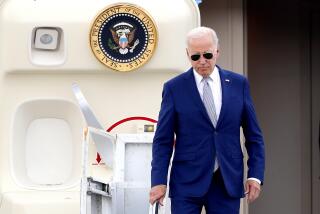Obama makes last Asia-trip pitch for U.S. exports
- Share via
Reporting from Yokohama, Japan — President Obama made a final push Saturday on selling more U.S. goods to the rest of the world as he closed out a 10-day tour of Asia in the land where the continent’s “economic miracle” was born.
Fresh from a disappointing summit of the world’s key economies in South Korea, where leaders largely rejected his call for immediate action to fix trade and currency imbalances, Obama warned that other nations should not assume the road to prosperity will be “simply paved with exports to America.”
“One of the important lessons the economic crisis taught us is the limits of depending primarily on American consumers and Asian exports to drive economic growth,” the president told a gathering of business leaders here during a meeting of 21 Asia-Pacific nations.
On a four-nation trip that also took him to India and Indonesia, Obama has pushed other countries to open up their markets so the U.S. can sell more products, reduce its huge trade and budget deficits and, ultimately, restructure its consumption-based economy into one that produces and creates wealth by selling more goods abroad.
Obama has couched his entire Asia trip as a mission primarily to create jobs for America.
But in prodding other economies to save less and spend and import more, Obama is asking them to make fundamental changes to an economic model that has been built up over decades, and won’t be easy to change.
Take Japan. The country’s economy began to take off in the 1950s and within two decades became the world’s third largest, thanks to an export machine that racked up large trade surpluses but also brought repeated clashes with the United States.
Yet even after the U.S. forced Japan to open up markets and significantly revalue its currency 25 years ago, it remains a country driven largely by exports. Its merchandise trade surplus with the U.S. was $45 billion last year — about the same as in 1985, not adjusting for inflation.
Some of Japan’s exports to the U.S. have shifted to China as Japanese companies, among others, move production to the Middle Kingdom.
And with Japan’s persistent problems of deflation and slow growth, U.S. economic policy in Asia has also shifted to China as Washington faces a bilateral trade deficit with Beijing that already had topped $200 billion through September.
One of Obama’s goals at the Group of 20 summit in Seoul was to focus scrutiny on China’s currency, but in the end, world leaders settled for a more general pledge that countries would refrain from “competitive devaluation.”
Chinese President Hu Jintao on Saturday gave no more ground on the issue, saying in a speech to the business group in this Japanese port city that Beijing would continue to reform its currency system in a “self-initiated, controllable and gradual manner.”
In other words, Beijing won’t be making the kind of moves toward currency appreciation that Washington wants.
But if Obama didn’t come away from this trip with meaty “deliverables,” he did have an opportunity to build relations with leaders of the world’s fastest-growing region, whose markets will help shape the economic future of America.
And he insisted throughout that it was not a zero-sum game.
“America is leading again in Asia,” Obama declared, alluding to criticisms in Asia and elsewhere that U.S. foreign policy had largely bypassed the region in recent years as Washington concentrated on its “war on terrorism.”
America’s interests in the region are linked closely to its longtime security presence, especially in South Korea and Japan. On Saturday, Obama appeared with Japanese Prime Minister Naoto Kan for an unusual moment in which Kan expressed appreciation for the U.S. military presence in Japan, a notable departure given tensions of the recent past.
The two announced an agreement to deepen their cooperation on nuclear security and nonproliferation, a relatively minor development but still a symbolic acknowledgement of one of Obama’s key long-term foreign policy goals.
Obama’s second extended tour of Asia as president ends Sunday, when he heads back to the U.S. to meet with soon-to-be-empowered Republicans and witness the final days of his Democratic Congress.
More to Read
Inside the business of entertainment
The Wide Shot brings you news, analysis and insights on everything from streaming wars to production — and what it all means for the future.
You may occasionally receive promotional content from the Los Angeles Times.












